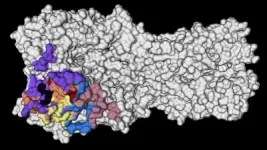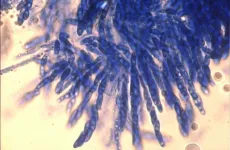Technique inspired by lace making could someday weave structures in space
2021-06-04
Lauren Dreier was paging through a 19th century book by the German architect Gottfried Semper when she spotted some intriguing patterns inspired by lace. A professional artist and designer who often incorporates technology into her work, Dreier, who is also a doctoral student at the School of Architecture at Princeton University, decided to recreate the printed illustrations in 3D.
She grabbed ribbon-like plastic material she had been experimenting with in her studio, bending and connecting the semi-rigid strips. To Dreier's surprise, the structure she built assumed a bumpy geometry, with four distinct hills and valleys. "I thought it would make a dome, but it was this unusual shape," Dreier said. Curious to know what caused ...
Lessons from the last pandemic point the way toward universal flu vaccines
2021-06-04
A new study from the University of Chicago and Scripps Research Institute shows that during the last great pandemic--2009's H1N1 influenza pandemic--people developed strong, effective immune responses to stable, conserved parts of the virus. This suggests a strategy for developing universal flu vaccines that are designed to generate those same responses, instead of targeting parts of the virus that tend to evolve rapidly and require a new vaccine every year.
Influenza is an elusive and frustrating target for vaccines. There are two main types of flu virus that can infect humans, which evolve rapidly from season to season. ...
Neurological symptoms like fatigue common in mild COVID
2021-06-04
Neurological and psychiatric symptoms such as fatigue and depression are common among people with Covid-19 and may be just as likely in people with mild cases, according to a new review study led by a UCL researcher.
By reviewing evidence from 215 studies of Covid-19, the meta-analysis published in the Journal of Neurology, Neurosurgery and Psychiatry reports a wide range of ways that Covid-19 can affect mental health and the brain.
Lead author Dr Jonathan Rogers (UCL Psychiatry and South London and Maudsley NHS Foundation Trust) said: "We had expected that neurological and psychiatric symptoms would be ...
70-year-old coffee-killing fungus brought back to life to fight the disease
2021-06-04
Researchers have re-animated specimens of a fungus that causes coffee wilt to discover how the disease evolved and how its spread can be prevented.
Coffee Wilt Disease is caused by a fungus that has led to devastating outbreaks since the 1920s in sub-Saharan Africa, and currently affects two of Africa's most popular coffee varieties: Arabica and Robusta.
The new research shows that the fungus likely boosted its ability to infect coffee plants by acquiring genes from a closely related fungus, which causes wilt disease on a wide range of crops, including ...
Arctic sea ice thinning faster than expected
2021-06-04
Sea ice in the coastal regions of the Arctic may be thinning up to twice as fast as previously thought, according to a new modelling study led by UCL researchers.
Sea ice thickness is inferred by measuring the height of the ice above the water, and this measurement is distorted by snow weighing the ice floe down. Scientists adjust for this using a map of snow depth in the Arctic that is decades out of date and does not account for climate change.
In the new study, published in the journal The Cryosphere, researchers swapped this map for the results of a new computer model designed to estimate snow depth as it varies year to year, and concluded that sea ice in key ...
Anxieties about side-effects and perceived trial uncertainties driving vaccine hesitancy
2021-06-04
Concerns about side effects and whether vaccines have been through enough testing are holding people back from getting vaccinated against COVID-19, according to a new report.
Data from an international survey of 15 countries* which ran between March and May this year showed that these were the most commonly cited reasons for not having had a coronavirus vaccine yet, in addition to not being eligible for one. Respondents' other commonly reported reasons included concerns about not getting the vaccine they would prefer, and worries over whether the vaccines are effective enough.
Led by Imperial College London's Institute of Global Health Innovation in collaboration with YouGov, the survey also looked at trust in COVID-19 vaccines. ...
Many COVID-19 patients produce immune responses against their body's tissues or organs
2021-06-04
A University of Birmingham-led study funded by the UK Coronavirus Immunology Consortium has found that many patients with COVID-19 produce immune responses against their body's own tissues or organs.
COVID-19 has been associated with a variety of unexpected symptoms, both at the time of infection and for many months afterwards. It is not fully understand what causes these symptoms, but one of the possibilities is that COVID-19 is triggering an autoimmune process where the immune system is misdirected to attack itself.
The study, published today (June 4) in the journal Clinical & Experimental Immunology, investigated the frequency and types of common ...
Prior COVID-19 infection reduces infection risk for up to 10 months
2021-06-04
Under embargo until Thursday 3 June, 23:30 UK time / 18:30 US Eastern time
Peer-reviewed observational study in people
Prior Covid-19 infection reduces infection risk for up to 10 months
The risk of being infected with SARS-CoV-2, the virus that causes Covid-19, is substantially reduced for up to 10 months following a first infection, according to new findings from the Vivaldi study led by UCL researchers.
For the study, published in Lancet Healthy Longevity, researchers looked at rates of Covid-19 infections between October and February among more than 2,000 care home residents and staff, comparing those who had evidence of a previous infection up to 10 months earlier, as determined by antibody testing, with those who had ...
Pfizer-BioNTech vaccine recipients have lower antibody levels targeting the Delta variant
2021-06-04
Levels of antibodies in the blood of vaccinated people that are able to recognise and fight the new SARS-CoV-2 Delta variant first discovered in India (B.1.617.2) are on average lower than those against previously circulating variants in the UK, according to new laboratory data from the Francis Crick Institute and the National Institute for Health Research (NIHR) UCLH Biomedical Research Centre, published today (Thursday) as a Research letter in The Lancet.
The results also show that levels of these antibodies are lower with increasing age and that levels decline over time, providing additional evidence in support of plans to deliver a vaccination boost to vulnerable people in the Autumn. ...
Immunotherapy drug delays recurrence in kidney cancer patients
2021-06-04
An immunotherapy drug given after surgery improved disease-free survival rates in patients with kidney cancer at high risk of relapse.
Interim results of a phase 3 trial of adjuvant therapy revealed a 32% decrease in the risk of recurrence or death with pembrolizumab compared with a placebo
This is the first positive study of immunotherapy in patients with kidney cancer at high risk of relapse.
BOSTON -- Treatment with an immunotherapy drug following kidney cancer surgery, prolonged disease-free survival rates in patients at high risk for recurrence, according to an interim ...
Genetic base editing treats sickle cell disease in mice
2021-06-03
Sickle cell disease (SCD) is the most common deadly genetic disorder, affecting more than 300,000 newborns worldwide each year. It leads to chronic pain, organ failure, and early death in patients. A team led by researchers at the Broad Institute of MIT and Harvard and St. Jude Children's Research Hospital has now demonstrated a base editing approach that efficiently corrects the mutation underlying SCD in patient blood stem cells and in mice. This gene editing treatment rescued the disease symptoms in animal models, enabling the long-lasting production of healthy blood cells.
The root of SCD is two mutated copies of the hemoglobin gene, HBB, which cause red ...
Secret shopper study sheds light on barriers to opioid treatment for women
2021-06-03
After a 2020 Vanderbilt University Medical Center study showed women have a difficult time accessing treatment for opioid use disorder (OUD), investigators analyzed comments received from the study's participants to further shed light on barriers to care, which included everything from long on-hold times to difficult interactions with clinic receptionists during phone calls seeking appointments.
A "secret shopper" study published in JAMA Network Open in 2020 used trained actors trying to get into treatment for opioid use disorder in 10 U.S. states. More than 10,000 unique "patients" were randomly assigned to be pregnant or non-pregnant and have private or Medicaid-based insurance to assess differences ...
Athletic competition after COVID
2021-06-03
MEMPHIS, Tenn. - Cardiovascular imaging demonstrated no evidence of myocardial injury or myocarditis in athletes after COVID-19 infection, according to a research letter published in Circulation by Le Bonheur Children's Hospital and the University of Tennessee Health Science Center cardiologists. The screening and evaluation was conducted by the Le Bonheur Children's Heart Institute Sports Cardiology team, Benjamin S. Hendrickson, MD, Ranjit R. Philip, MD, and Ryan E. Stephens, NP-C, MBA, and Le Bonheur Director of Cardiac MRI Jason N. Johnson, MD, MHS. Researchers say this study confirms existing recommendations ...
Mockingbird song decoded
2021-06-03
The North American mockingbird is famous for its ability to imitate the song of other birds. But it doesn't just mimic its kindred species, it actually composes its own songs based on other birds' melodies. An interdisciplinary research team has now worked out how exactly the mockingbird constructs its imitations. The scientists determined that the birds follow similar musical rules as those found in human music, from Beethoven to Kendrick Lamar.
The song of the mockingbird is so complex that to investigate it required a joint effort of experts from very different fields. Neuroscientist Tina Roeske of the Max Planck Institute for Empirical Aesthetics, field biologist Dave Gammon of Elon University, ...
The dream team: Scientists find drug duo that may cure COVID-19 together
2021-06-03
COVID-19 continues to claim lives across the world and is infecting millions more. Although several vaccines have recently become available, making significant strides towards preventing COVID-19, what about the treatment of those who already have the infection? Vaccines aren't 100% effective, highlighting the need--now more than ever--for effective antiviral therapeutics. Moreover, some people can't receive vaccines due to health issues, and new variants of SARS-CoV-2, the virus that causes COVID-19, that can penetrate vaccine-conferred immunity, are being reported, indicating that we need to think beyond prevention.
Given this need, a team of researchers based in Japan, the US, and the UK launched a project to develop effective therapeutics. ...
New algorithm for modern quilting
2021-06-03
Stanford University computer science graduate student Mackenzie Leake has been quilting since age 10, but she never imagined the craft would be the focus of her doctoral dissertation. Included in that work is new prototype software that can facilitate pattern-making for a form of quilting called foundation paper piecing, which involves using a backing made of foundation paper to lay out and sew a quilted design.
Developing a foundation paper piece quilt pattern - which looks similar to a paint-by-numbers outline - is often non-intuitive. There are few formal guidelines for patterning and those that ...
Cultural, belief system data can inform gray wolf recovery efforts in US
2021-06-03
Humans regularly exert a powerful influence on the survival and persistence of species, yet social-science information is used only sporadically in conservation decisions.
Researchers at Colorado State University and The Ohio State University have created an index depicting the mix of social values among people across all 50 states, providing data that can be useful for wildlife conservation policy and management.
As a specific illustration, the research team found a supportive social context for gray wolf reintroduction in Colorado. Last fall, citizens ...
Immunotherapy after bladder cancer surgery may reduce recurrence, study shows
2021-06-03
NEW YORK CITY, June 2, 2021 -- New research from Memorial Sloan Kettering Cancer Center (MSK) medical oncologist Dean Bajorin, MD, and colleagues found that patients who received nivolumab (Opdivo®) after bladder cancer surgery reduced their overall risk for high-grade bladder cancer recurrence. This research was published in the New England Journal of Medicine.
In this phase III randomized study, Dr. Bajorin and a team of investigators evaluated 709 patients who were at high risk for recurrence of urothelial cancer after removal of their bladder, ureter, or kidney for high-grade cancer. To evaluate for benefit, patients were randomized to receive either nivolumab or a placebo every two weeks for one year. Patients and ...
Linked faults under Salt Lake City may elevate risk of building damage
2021-06-03
A complex zone of folding and faulting that links two faults underneath downtown Salt Lake City could deform the ground during a large earthquake, according to a new study.
The findings, published in the open-access journal The Seismic Record, suggest that earthquakes magnitude 5.0 and larger could cause ground displacement and liquefaction in Salt Lake City that increase the risk of earthquake-related building damage.
As part of the Wasatch Fault Zone, the region has a complex seismic history, with at least 24 large earthquakes occurring in the urbanized parts of the zone over the past 7000 years. Along with previous excavation, borehole and other geophysical studies, the new research also supports the possibility of through-going ruptures ...
CO2 emissions are rebounding, but clean energy revolutions are emerging
2021-06-03
At the upcoming Conference of the Parties (COP26) in November, ample discussion is likely to focus on how the world is not on track to meet the Paris Agreement's goals of stopping warming at well below 2°C. According to a new University of California San Diego article published in Nature Energy, world diplomats will, however, find encouraging signs in emerging clean energy technology "niches"--countries, states or corporations--that are pioneering decarbonization.
"In certain areas, adoption rates for solar and wind turbines, as well as electric vehicles are very high and increasing every year," write the authors of the opinion piece Ryan Hanna, assistant research scientist at UC San Diego's Center ...
Analyzing tumor microenvironment at single cell level sheds light on metastatic melanoma outcomes
2021-06-03
TAMPA, Fla. -- There are several new treatment options available for patients with advanced melanoma. While these therapies have greatly improved the prognosis for patients, each person can respond to the treatments differently. Treatment of melanomas that have spread to the central nervous system is especially challenging. In a new article published in Clinical Cancer Research, Moffitt Cancer Center researchers reveal how different therapies impact the surrounding immune environment of metastatic melanoma tumors according to location and identify a rare population of immune cells that is associated with improved overall survival.
Different types of cancer tend to spread to specific sites throughout the body. Common sites of melanoma ...
Shoot better drone videos with a single word
2021-06-03
The pros make it look easy, but making a movie with a drone can be anything but.
First, it takes skill to fly the often expensive pieces of equipment smoothly and without crashing. And once you've mastered flying, there are camera angles, panning speeds, trajectories and flight paths to plan.
With all the sensors and processing power onboard a drone and embedded in its camera, there must be a better way to capture the perfect shot.
"Sometimes you just want to tell the drone to make an exciting video," said Rogerio Bonatti, a Ph.D. candidate in Carnegie Mellon University's Robotics Institute.
Bonatti was part ...
Researchers design simulation tool to predict disease, pest spread
2021-06-03
North Carolina State University researchers have developed a computer simulation tool to predict when and where pests and diseases will attack crops or forests, and also test when to apply pesticides or other management strategies to contain them.
"It's like having a bunch of different Earths to experiment on to test how something will work before spending the time, money and effort to do it," said the study's lead author Chris Jones, research scholar at North Carolina State University's Center for Geospatial Analytics.
In the journal Frontiers in Ecology and the Environment, researchers reported on their efforts to develop and test ...
URI scientists discover function of microbes living in oysters
2021-06-03
KINGSTON, R.I. - June 3, 2021 - Scientists from the University of Rhode Island have taken the first steps toward understanding the function of microbes that live on and in Eastern oysters, which may have implications for oyster health and the management of oyster reefs and aquaculture facilities.
"Marine invertebrates like oysters, corals and sponges have a very active microbiome that could potentially play a role in the function of the organism itself," said Ying Zhang, URI associate professor of cell and molecular biology. "We know very little about whether there are resident microbes in oysters, and if there are, what their function may be or how they may help or bring harm to the oyster."
Zhang and doctoral student Zachary Pimentel extracted the DNA of microbes living in ...
COVID's impact on pregnancy, birth trends
2021-06-03
ANN ARBOR, Mich. -- A different type of surge may be on the way more than a year into the pandemic - a baby surge.
The COVID-19 shutdown initially seemed to hit pause on pregnancy and birth rates, new research from one major hospital system suggests, but that trend is quickly reversing.
"Birth rates declined early on in the pandemic, but we expect a dramatic rebound soon," says lead author Molly Stout, M.D., MSci, maternal fetal medicine director at Michigan Medicine Von Voigtlander Women's Hospital.
"We're already seeing signs of a summer baby surge."
While infectious ...
[1] ... [2150]
[2151]
[2152]
[2153]
[2154]
[2155]
[2156]
[2157]
2158
[2159]
[2160]
[2161]
[2162]
[2163]
[2164]
[2165]
[2166]
... [8720]
Press-News.org - Free Press Release Distribution service.











